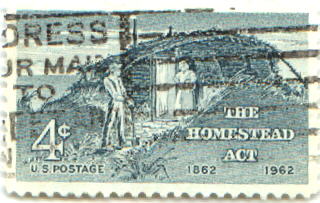Early Farm Policy
The governing bodies of the American colonies raised questions about land distribution and use soon after winning independence. In 1787, the Northwest Ordinance provided for surveying the West, with the intention of opening up land for family farms. Areas between the Ohio and Mississippi rivers, for example, were allowed to become states on equal terms with the original 13 states as soon as their populations reached a certain level. The lands were to be sold at $2.50 per hectare.Most of the settlers who braved the many dangers of western expansion did not have money to pay for land. Often they settled as "squatters" without any clear title to their farms. After becoming established, these settlers campaigned to get the law changed so that some of the land was declared free, while other lands could be bought at a minimal price and paid for over a period of years.
 Successive laws culminated in the Homestead Act of 1862, giving
free land to prospective settlers provided they agreed to
"homestead" or live on the land for a period of years. The
strategy behind this and subsequent laws was to get land into the
hands of family farmers. In 1862 the Morrill Act awarded other
federal lands to each state government for the purpose of
endowing a system of agricultural and technical colleges. The 69
"land grant colleges" thus created have played a key role in
advancing agricultural research and educating successive
generations of farmers.
Successive laws culminated in the Homestead Act of 1862, giving
free land to prospective settlers provided they agreed to
"homestead" or live on the land for a period of years. The
strategy behind this and subsequent laws was to get land into the
hands of family farmers. In 1862 the Morrill Act awarded other
federal lands to each state government for the purpose of
endowing a system of agricultural and technical colleges. The 69
"land grant colleges" thus created have played a key role in
advancing agricultural research and educating successive
generations of farmers.
As the 20th century began, agricultural leaders became concerned that the government's research findings were not reaching farmers. To show how new techniques might help farmers improve crop yields, the government set up a limited number of "demonstration farms" and joined with local business and farm groups to hire a limited number of "demonstration agents." In 1914 Congress gave this idea national scope with the establishment of a new "agricultural extension service." Financed jointly by the federal government and each state's land grant colleges, the service hired agents to establish offices in each local governmental district to provide advice to farmers and their families.
In the period between 1900 and 1930, the Department of Agriculture also began an intensive program of basic research. This helped farmers and the general public in many ways. For example, new stocks of hogs imported from the British Isles and Europe were crossbred to produce hogs that fattened faster on less grain. Soil was tested to determine the kind of fertilizers needed to increase grain production. Other types of experimentation produced dramatic results in hybrid seed, plant nutrition, treatment of plant and animal diseases, and pest control.
